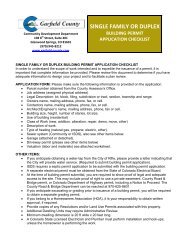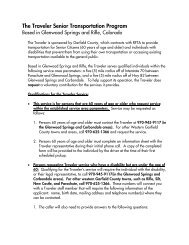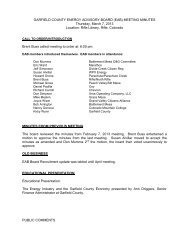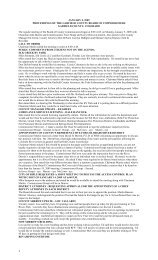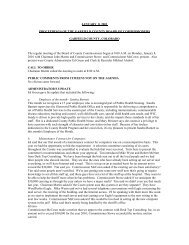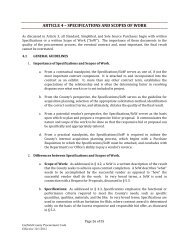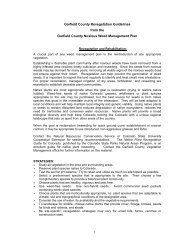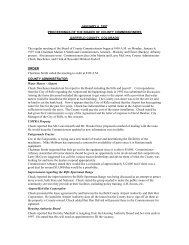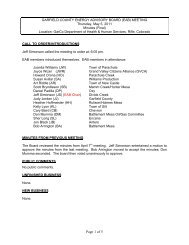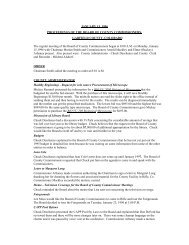5.4 Fracturing Fluid - Garfield County, Colorado
5.4 Fracturing Fluid - Garfield County, Colorado
5.4 Fracturing Fluid - Garfield County, Colorado
Create successful ePaper yourself
Turn your PDF publications into a flip-book with our unique Google optimized e-Paper software.
<strong>5.4</strong> <strong>Fracturing</strong> <strong>Fluid</strong><br />
The fluid used for slickwater fracturing is typically comprised of more than<br />
98% fresh water and<br />
sand, with chemical additives comprising 2% or less of the fluid.21 The<br />
Department has collected<br />
compositional information on many of the additives proposed for use in<br />
fracturing shale<br />
formations in New York directly from chemical suppliers and service companies.<br />
This<br />
17 ICF International, 2009. Technical Assistance for the Draft Supplemental Generic EIS: Oil, Gas and Solution Mining<br />
Regulatory Program. NYSERDA Agreement No. 9679. pp. 10, 19.<br />
18 Ibid.<br />
19 Ibid., p. 12.<br />
20 Ibid., p. 19.<br />
21 GWPC, 2009a. Modern Shale Gas Development in the United States: A Primer, pp. 61-62.<br />
DRAFT SGEIS 9/30/2009, Page 5-33<br />
information has been evaluated by the Department’s Air Resources and Water<br />
Divisions as well<br />
as the Bureaus of Water Supply Protection and Toxic Substances Assessment in<br />
the New York<br />
State Department of Health. It has also been reviewed by technical consultants<br />
contracted by<br />
NYSERDA22 to conduct research related to the preparation of this document.<br />
Discussion of<br />
potential environmental impacts and mitigation measures in Chapters 6 and 7 of<br />
this SGEIS<br />
reflect analysis and input by all of the foregoing entities.<br />
Six service companies23 and twelve chemical suppliers24 have provided additive<br />
product<br />
compositional information to the Department that includes more complete<br />
information than is<br />
available on product Material Safety Data Sheets (MSDSs)25. Altogether, some<br />
compositional<br />
information is on file with the Department for 197 products, with complete<br />
compositional<br />
information on file for 152 of those products. Within these products are<br />
approximately 260<br />
unique chemicals whose CAS Numbers have been disclosed to the Department and<br />
an additional<br />
40 compounds which require further disclosure since many are mixtures. Table<br />
5.3 is an<br />
alphabetical list of all products for which complete chemical information has<br />
been provided to
the Department. Table <strong>5.4</strong> is an alphabetical list of products for which only<br />
partial chemical<br />
composition information has been provided to the Department. Any product whose<br />
name does<br />
not appear within Table 5.3 or Table <strong>5.4</strong> was not evaluated in this SGEIS<br />
either because no<br />
chemical information was submitted to the Department or because the product<br />
was not proposed<br />
for use in fracturing operations at Marcellus shale wells or other wells<br />
targeting other lowpermeability<br />
gas reservoirs. MSDSs are on file with the Department for most of the products<br />
listed. The Department considers MSDSs to be public information ineligible for<br />
exception from<br />
disclosure as trade secrets or confidential business information.<br />
22 Alpha Environmental Consultants, Inc., ICF International, URS Corporation<br />
23 BJ Services, Frac Tech Services, Halliburton, Superior Well Services, Universal Well Services,<br />
Schlumberger, Superior Well<br />
Services<br />
24 Baker Petrolite, CESI/Floteck, Champion Technologies/Special Products, Chem EOR, Cortec, Industrial<br />
Compounding,<br />
Kemira, Nalco, PfP Technologies, SNF Inc., Weatherford/Clearwater, and WSP Chemicals & Technology<br />
25 MSDSs are designed to provide employees and emergency personnel with proper procedures for handling,<br />
working with, and<br />
storing a particular substance and are regulated by the Occupational Safety and Health Administration<br />
(OSHA)’s Hazard<br />
Communication Standard, 29 CFR 1910.1200(g).<br />
DRAFT SGEIS 9/30/2009, Page 5-34<br />
Table 5-3 <strong>Fracturing</strong> Additive Products – Full Composition Disclosure<br />
Made to the Department<br />
Product Name<br />
ABF<br />
Acetic Acid 0.1-10%<br />
Acid Pensurf / Pensurf<br />
Activator W<br />
AGA 150 / Super Acid Gell 150<br />
AI-2<br />
Aldacide G<br />
Alpha 125<br />
Ammonium Persulfate/OB Breaker<br />
APB-1, Ammonium Persulfate Breaker<br />
AQF-2<br />
ASP-820<br />
B315 / Friction Reducer B315<br />
B317 / Scale Inhibitor B317<br />
B859 / EZEFLO Surfactant B859 / EZEFLO F103 Surfactant<br />
B867 / Breaker B867 / Breaker J218<br />
B868 / EB-CLEAN B868 LT Encapsulated Breaker / EB-Clean J479 LT Encapsulated<br />
Breaker
B869 / Corrosion Inhibitor B869 / Corrosion Inhibitor A262<br />
B875 / Borate Crosslinker B875 / Borate Crosslinker J532<br />
B880 / EB-CLEAN B880 Breaker / EB-CLEAN J475 Breaker<br />
B890 / EZEFLO Surfactant B890 / EZEFLO F100 Surfactant<br />
B900 / EZEFLO Surfactant B900/ EZEFLO F108 Surfactant<br />
B910 / Corrosion Inhibitor B910 / Corrosion Inhibitor A264<br />
B916 / Gelling Agent ClearFRAC XT B916 / Gelling Agent ClearFRAC XT J590<br />
BA-2<br />
BA-20<br />
BA-40L<br />
BA-40LM<br />
BC-140<br />
BC-140 X2<br />
BE-3S<br />
DRAFT SGEIS 9/30/2009, Page 5-35<br />
BE-6<br />
BE-7<br />
BE-9<br />
Bentone A-140<br />
BF-1<br />
BF-7 / BF-7L<br />
BioClear 1000 / Unicide 1000<br />
Bio-Clear 200 / Unicide 2000<br />
Breaker FR<br />
BXL-2, Crosslinker/ Buffer<br />
BXL-STD / XL-300MB<br />
Carbon Dioxide<br />
CL-31<br />
CLA-CHEK LP<br />
CLA-STA XP<br />
Clay Treat PP<br />
Clay Treat TS<br />
Clay Treat-3C<br />
Clayfix II<br />
Clayfix II plus<br />
Cronox 245 ES/ CI-14<br />
CS-250 SI<br />
CS-650 OS, Oxygen Scavenger<br />
CS-Polybreak 210<br />
CS-Polybreak 210 Winterized<br />
EB-4L<br />
Enzyme G-NE<br />
FE-1A<br />
FE-2<br />
FE-2A<br />
FE-5A<br />
Ferchek<br />
Ferchek A<br />
Ferrotrol 300L<br />
Flomax 50
Flomax 70 / VX9173<br />
FLOPAM DR-6000 / DR-6000<br />
FLOPAM DR-7000 / DR-7000<br />
Formic Acid<br />
FR-46<br />
FR-48W<br />
DRAFT SGEIS 9/30/2009, Page 5-36<br />
FR-56<br />
FRP-121<br />
FRW-14<br />
GasPerm 1000<br />
GBL-8X / LEB-10X / GB-L / En-breaker<br />
GBW-20C<br />
GBW-30 Breaker<br />
Green-Cide 25G / B244 / B244A<br />
H015 / Hydrochloric Acid 15% H15<br />
HAI-OS Acid Inhibitor<br />
HC-2<br />
High Perm SW-LB<br />
HPH Breaker<br />
HPH foamer<br />
Hydrochloric Acid<br />
Hydrochloric Acid (HCl)<br />
HYG-3<br />
IC 100L<br />
ICA-720 / IC-250<br />
ICA-8 / IC-200<br />
ICI-3240<br />
Inflo-250<br />
InFlo-250W / InFlo-250 Winterized<br />
Iron Check / Iron Chek<br />
Iron Sta IIC / Iron Sta II<br />
Isopropyl Alcohol<br />
J313 / Water Friction-Reducing Agen J313<br />
J534 / Urea Ammonium Nitrate Solution J534<br />
J580 / Water Gelling Agent J580<br />
K-34<br />
K-35<br />
KCI<br />
L058 / Iron Stabilizer L58<br />
L064 / Temporary Clay Stabilizer L64<br />
LGC-35 CBM<br />
LGC-36 UC<br />
LGC-VI UC<br />
Losurf 300M<br />
M003 / Soda Ash M3<br />
MA-844W<br />
Methanol<br />
DRAFT SGEIS 9/30/2009, Page 5-37<br />
MO-67
Morflo III<br />
MSA-II<br />
Muriatic Acid 36%<br />
Musol A<br />
N002 / Nitrogen N2<br />
NCL-100<br />
Nitrogen<br />
Para Clear D290 / ParaClean II<br />
Paragon 100 E+<br />
PLURADYNE TDA 6<br />
PSA-2L<br />
PSI-720<br />
PSI-7208<br />
SAS-2<br />
Scalechek LP-55<br />
Scalechek LP-65<br />
Scalehib 100 / Super Scale Inhibitor / Scale Clear SI-112<br />
SGA II<br />
Shale Surf 1000<br />
Shale Surf 1000 Winterized<br />
Sodium Citrate<br />
SP Breaker<br />
STIM-50 / LT-32<br />
Super OW 3<br />
Super Pen 2000<br />
SuperGel 15<br />
U042 / Chelating Agent U42<br />
U066 / Mutual Solvent U66<br />
Unicide 100 / EC6116A<br />
Unifoam<br />
Unigel 5F<br />
UniHibA / SP-43X<br />
UnihibG / S-11<br />
Unislik ST 50 / Stim Lube<br />
Vicon NF<br />
WG-11<br />
WG-17<br />
WG-18<br />
WG-35<br />
DRAFT SGEIS 9/30/2009, Page 5-38<br />
WG-36<br />
WLC-6<br />
XL-1<br />
XL-8<br />
XLW-32<br />
Xylene<br />
Table 5-4 <strong>Fracturing</strong> Additive Products – Partial Composition Disclosure to<br />
the Department<br />
Product Name<br />
20 Degree Baume Muriatic Acid
AcTivator / 78-ACTW<br />
AMB-100<br />
B885 / ClearFRAC LT B885 / ClearFRAC LT J551A<br />
B892 / EZEFLO B892 / EZEFLO F110 Surfactant<br />
CL-22UC<br />
Clay Master 5C<br />
Corrosion Inhibitor A261<br />
FAW- 5<br />
FDP-S798-05<br />
FDP-S819-05<br />
FE ACID<br />
FR-48<br />
FRW-16<br />
FRW-18<br />
FRW-25M<br />
GA 8713<br />
GBW-15C<br />
GBW-15L<br />
GW-3LDF<br />
HVG-1, Fast Hydrating Guar Slurry<br />
ICA 400<br />
Inflo-102<br />
J134L / Enzyme Breaker J134L<br />
KCLS-2, KCL Substitute<br />
L065 / Scale Inhibitor L065<br />
LP-65<br />
Magnacide 575 Microbiocide<br />
MSA ACID<br />
DRAFT SGEIS 9/30/2009, Page 5-39<br />
Multifunctional Surfactant F105<br />
Nitrogen, Refrigerated Liquid<br />
OptiKleen-WF<br />
Parasperse Cleaner<br />
Product 239<br />
S-150<br />
SandWedge WF<br />
Scalechek SCP-2<br />
SilkWater FR-A<br />
Super Sol 10/20/30<br />
Unislick 30 / Cyanaflo 105L<br />
WC-5584<br />
WCS 5177 Corrosion Scale Inhibitor<br />
WCW219 Combination Inhibitor<br />
WF-12B Foamer<br />
WF-12B Salt Inhibitor Stix<br />
WF-12B SI Foamer/Salt Inhibitor<br />
WF12BH Foamer<br />
WFR-C
Information in sections <strong>5.4</strong>.1-3 below was compiled primarily by URS<br />
Corporation, under<br />
contract to NYSERDA.<br />
<strong>5.4</strong>.1 Properties of <strong>Fracturing</strong> <strong>Fluid</strong>s<br />
Additives are used in hydraulic fracturing operations to elicit certain<br />
properties and<br />
characteristics that would aide and enhance the operation. The desired<br />
properties and<br />
characteristics include:<br />
• Non-reactive<br />
• Non-flammable<br />
• Minimal residuals<br />
• Minimal potential for scale or corrosion.<br />
• Low entrained solids<br />
• Neutral pH (pH 6.5 – 7.5) for maximum polymer hydration<br />
DRAFT SGEIS 9/30/2009, Page 5-40<br />
• Limited formation damage<br />
• Appropriately modify properties of water to carry proppant deep into the<br />
shale<br />
• Economical to modify fluid properties<br />
• Minimal environmental effects<br />
<strong>5.4</strong>.2 Classes of Additives<br />
Table 5.5 lists the types, purposes and examples of additives that have been<br />
proposed to date for<br />
use in hydraulic fracturing of gas wells in New York State.<br />
Table 5-5 - Types and Purposes of Additives Proposed for Use in New York<br />
State<br />
Additive Type Description of Purpose Examples of<br />
Chemicals26<br />
Proppant “Props” open fractures and allows gas / fluids<br />
to flow more freely to the well bore.<br />
Sand<br />
[Sintered bauxite;<br />
zirconium oxide; ceramic<br />
beads]<br />
Acid Cleans up perforation intervals of cement and<br />
drilling mud prior to fracturing fluid injection,<br />
and provides accessible path to formation.<br />
Hydrochloric acid (HCl,<br />
3% to 28%)<br />
Breaker Reduces the viscosity of the fluid in order to<br />
release proppant into fractures and enhance<br />
the recovery of the fracturing fluid.<br />
Peroxydisulfates<br />
Bactericide /<br />
Biocide<br />
Inhibits growth of organisms that could<br />
produce gases (particularly hydrogen sulfide)
that could contaminate methane gas. Also<br />
prevents the growth of bacteria which can<br />
reduce the ability of the fluid to carry proppant<br />
into the fractures.<br />
Gluteraldehyde; 2-Bromo-<br />
2-nitro-1,2-propanediol<br />
Clay Stabilizer /<br />
Control<br />
Prevents swelling and migration of formation<br />
clays which could block pore spaces thereby<br />
reducing permeability.<br />
Salts (e.g., tetramethyl<br />
ammonium chloride)<br />
[Potassium chloride (KCl)]<br />
Corrosion<br />
Inhibitor<br />
Reduces rust formation on steel tubing, well<br />
casings, tools, and tanks (used only in<br />
fracturing fluids that contain acid).<br />
Methanol<br />
Crosslinker The fluid viscosity is increased using<br />
phosphate esters combined with metals. The<br />
metals are referred to as crosslinking agents.<br />
The increased fracturing fluid viscosity allows<br />
Potassium hydroxide<br />
26 Chemicals in brackets [ ] have not been proposed for use in the State of New York to date, but are<br />
known to be used in other<br />
states or shale formations.<br />
DRAFT SGEIS 9/30/2009, Page 5-41<br />
Additive Type Description of Purpose Examples of<br />
Chemicals26<br />
the fluid to carry more proppant into the<br />
fractures.<br />
Friction Reducer Allows fracture fluids to be injected at<br />
optimum rates and pressures by minimizing<br />
friction.<br />
Sodium acrylateacrylamide<br />
copolymer;<br />
polyacrylamide (PAM)<br />
Gelling Agent Increases fracturing fluid viscosity, allowing<br />
the fluid to carry more proppant into the<br />
fractures.<br />
Guar gum<br />
Iron Control Prevents the precipitation of metal oxides<br />
which could plug off the formation.<br />
Citric acid; thioglycolic<br />
acid<br />
Scale Inhibitor Prevents the precipitation of carbonates and<br />
sulfates (calcium carbonate, calcium sulfate,<br />
barium sulfate) which could plug off the<br />
formation.<br />
Ammonium chloride;<br />
ethylene glycol;<br />
polyacrylate<br />
Surfactant Reduces fracturing fluid surface tension<br />
thereby aiding fluid recovery.
Methanol; isopropanol<br />
<strong>5.4</strong>.3 Composition of <strong>Fracturing</strong> <strong>Fluid</strong>s<br />
The composition of the fracturing fluid used may vary from one geologic basin<br />
or formation to<br />
another in order to meet the specific needs of each operation; but the range<br />
of additive types<br />
available for potential use remains the same. There are a number of different<br />
chemical<br />
compositions for each additive type; however, only one product of each type is<br />
typically utilized<br />
in any given gas well. The selection may be driven by the formation and<br />
potential interactions<br />
between additives. Additionally not all additive types will be utilized in<br />
every fracturing job.<br />
A sample composition by weight of fracture fluid is provided in Figure 5.3;<br />
this composition is<br />
based on data from the Fayetteville Shale.27 Based on this data, approximately<br />
90 percent of the<br />
fracture fluid is water; another approximately 9 percent is proppant (see<br />
Photo 5.17); the<br />
remainder, typically less than 0.5 percent consists of chemical additives<br />
listed above.<br />
27 Similar to the Marcellus Shale, the Fayetteville Shale is a marine shale rich in unoxidized carbon<br />
(i.e. a black shale). The two<br />
shales are at similar depths, and vertical and horizontal wells have been drilled/fractured at both<br />
shales.<br />
DRAFT SGEIS 9/30/2009, Page 5-42<br />
Photo 5.17 - Sand used in hydraulic fracturing operation in Bradford<br />
<strong>County</strong>, PA.<br />
Barnett Shale is considered to be the first instance of extensive high-volume<br />
hydraulic fracture<br />
technology use; the technology has since been applied in other areas such as<br />
the Fayetteville<br />
Shale and the Haynesville Shale. URS notes that data collected from<br />
applications to drill<br />
Marcellus Shale wells in New York indicate that the typical fracture fluid<br />
composition for<br />
operations in the Marcellus Shale is similar to the provided composition in<br />
the Fayetteville<br />
Shale.<br />
Even though no horizontal wells have been drilled in the Marcellus Shale in<br />
New York,
applications filed to date indicate that it is realistic to expect that the<br />
composition of fracture<br />
fluids used in the Marcellus Shale would be similar from one operation to the<br />
next. One<br />
potential exception is that additional data provided separately to the<br />
Department indicates that<br />
biocides have comprised up to 0.03% of fracturing fluid instead of 0.001% as<br />
noted in Figure<br />
5.3.<br />
DRAFT SGEIS 9/30/2009, Page 5-43<br />
Other, 0.44%<br />
Scale Inhibitor, 0.04%<br />
Surfactant, 0.08%<br />
pH Adjusting Agent, 0.01%<br />
Acid, 0.11%<br />
Breaker, 0.01%<br />
Bactericide/Biocide, 0.001%<br />
Corrosion Inhibitor, 0.001%<br />
Crosslinker, 0.01%<br />
Iron Control, 0.004%<br />
Gelling Agent, 0.05%<br />
Clay Stabilizer/Controler,<br />
0.05%<br />
Friction Reducer, 0.08%<br />
Water, 90.60%<br />
Proppant, 8.96%<br />
Figure 5-3 - Sample Fracture <strong>Fluid</strong> Composition by Weight<br />
Each product within the twelve classes of additives may be made up of one or<br />
more chemical<br />
constituents. Table 5.6 is a list of chemical constituents and their CAS<br />
numbers, that have been<br />
extracted from complete product chemical compositional information and<br />
Material Safety Data<br />
Sheets submitted to the NYSDEC for nearly 200 products used or proposed for<br />
use in hydraulic<br />
fracturing operations in the Marcellus Shale area of New York. It is important<br />
to note that<br />
several manufacturers and suppliers provide similar chemicals (i.e. chemicals<br />
that would serve<br />
the same purpose) for any class of additive, and that not all types of<br />
additives are used in a single<br />
well. Table 5.6 represents constituents of all hydraulic-fracturing-related<br />
chemicals submitted to<br />
NYSDEC to date for potential use at shale wells in the State, only a handful<br />
of which would be<br />
utilized in a single well.<br />
Data provided to NYSDEC to date indicates similar fracturing fluid<br />
compositions for vertically<br />
and horizontally drilled wells.<br />
DRAFT SGEIS 9/30/2009, Page 5-44
Table 5-6 - Chemical Constituents in Additives/Chemicals28,29<br />
CAS Number30 Chemical Constituent<br />
2634-33-5 1,2 Benzisothiazolin-2-one / 1,2-benzisothiazolin-3-one<br />
95-63-6 1,2,4 trimethylbenzene<br />
123-91-1 1,4 Dioxane<br />
3452-07-1 1-eicosene<br />
629-73-2 1-hexadecene<br />
112-88-9 1-octadecene<br />
1120-36-1 1-tetradecene<br />
10222-01-2 2,2 Dibromo-3-nitrilopropionamide<br />
27776-21-2 2,2'-azobis-{2-(imidazlin-2-yl)propane}-dihydrochloride<br />
73003-80-2 2,2-Dobromomalonamide<br />
15214-89-8 2-Acrylamido-2-methylpropanesulphonic acid sodium salt polymer<br />
46830-22-2 2-acryloyloxyethyl(benzyl)dimethylammonium chloride<br />
52-51-7 2-Bromo-2-nitro-1,3-propanediol<br />
111-76-2 2-Butoxy ethanol<br />
1113-55-9 2-Dibromo-3-Nitriloprionamide (2-Monobromo-3-nitriilopropionamide)<br />
104-76-7 2-Ethyl Hexanol<br />
67-63-0 2-Propanol / Isopropyl Alcohol / Isopropanol / Propan-2-ol<br />
26062-79-3 2-Propen-1-aminium, N,N-dimethyl-N-2-propenyl-chloride, homopolymer<br />
9003-03-6 2-propenoic acid, homopolymer, ammonium salt<br />
25987-30-8 2-Propenoic acid, polymer with 2 p-propenamide, sodium salt / Copolymer of<br />
acrylamide and sodium acrylate<br />
71050-62-9 2-Propenoic acid, polymer with sodium phosphinate (1:1)<br />
66019-18-9 2-propenoic acid, telomer with sodium hydrogen sulfite<br />
107-19-7 2-Propyn-1-ol / Progargyl Alcohol<br />
51229-78-8 3,5,7-Triaza-1-azoniatricyclo[3.3.1.13,7]decane, 1-(3-chloro-2-propenyl)-<br />
chloride,<br />
115-19-5 3-methyl-1-butyn-3-ol<br />
127087-87-0 4-Nonylphenol Polyethylene Glycol Ether Branched / Nonylphenol<br />
ethoxylated / Oxyalkylated Phenol<br />
64-19-7 Acetic acid<br />
68442-62-6 Acetic acid, hydroxy-, reaction products with triethanolamine<br />
108-24-7 Acetic Anhydride<br />
67-64-1 Acetone<br />
79-06-1 Acrylamide<br />
28 Table 5.6 is a list of chemical constituents and their CAS numbers that have been extracted from<br />
complete chemical<br />
compositions and Material Safety Data Sheets submitted to the NYSDEC.<br />
29 These are the chemical constituents of all chemical additives proposed to be used in New York for<br />
hydraulic fracturing<br />
operations at shale wells. Only a few chemicals will be used in a single well; the list of chemical<br />
constituents used in an<br />
individual well will be correspondingly smaller.<br />
30 Chemical Abstracts Service (CAS) is a division of the American Chemical Society. CAS assigns unique<br />
numerical identifiers<br />
to every chemical described in the literature. The intention is to make database searches more<br />
convenient, as chemicals often<br />
have many names. Almost all molecule databases today allow searching by CAS number.<br />
DRAFT SGEIS 9/30/2009, Page 5-45<br />
CAS Number30 Chemical Constituent
38193-60-1 Acrylamide - sodium 2-acrylamido-2-methylpropane sulfonate copolymer<br />
25085-02-3 Acrylamide - Sodium Acrylate Copolymer or Anionic Polyacrylamide<br />
69418-26-4 Acrylamide polymer with N,N,N-trimethyl-2[1-oxo-2-propenyl]oxy<br />
Ethanaminium chloride<br />
15085-02-3 Acrylamide-sodium acrylate copolymer<br />
68551-12-2 Alcohols, C12-C16, Ethoxylated (a.k.a. Ethoxylated alcohol)<br />
64742-47-8 Aliphatic Hydrocarbon / Hydrotreated light distillate / Petroleum Distillates /<br />
Isoparaffinic Solvent / Paraffin Solvent / Napthenic Solvent<br />
64743-02-8 Alkenes<br />
68439-57-6 Alkyl (C14-C16) olefin sulfonate, sodium salt<br />
9016-45-9 Alkylphenol ethoxylate surfactants<br />
1327-41-9 Aluminum chloride<br />
73138-27-9 Amines, C12-14-tert-alkyl, ethoxylated<br />
71011-04-6 Amines, Ditallow alkyl, ethoxylated<br />
68551-33-7 Amines, tallow alkyl, ethoxylated, acetates<br />
1336-21-6 Ammonia<br />
631-61-8 Ammonium acetate<br />
68037-05-8 Ammonium Alcohol Ether Sulfate<br />
7783-20-2 Ammonium bisulfate<br />
10192-30-0 Ammonium Bisulphite<br />
12125-02-9 Ammonium Chloride<br />
7632-50-0 Ammonium citrate<br />
37475-88-0 Ammonium Cumene Sulfonate<br />
1341-49-7 Ammonium hydrogen-difluoride<br />
6484-52-2 Ammonium nitrate<br />
7727-54-0 Ammonium Persulfate / Diammonium peroxidisulphate<br />
1762-95-4 Ammonium Thiocyanate<br />
7664-41-7 Aqueous ammonia<br />
121888-68-4 Bentonite, benzyl(hydrogenated tallow alkyl) dimethylammonium stearate<br />
complex / organophilic clay<br />
71-43-2 Benzene<br />
119345-04-9 Benzene, 1,1'-oxybis, tetratpropylene derivatives, sulfonated, sodium salts<br />
74153-51-8 Benzenemethanaminium, N,N-dimethyl-N-[2-[(1-oxo-2-propenyl)oxy]ethyl]-<br />
, chloride, polymer with 2-propenamide<br />
10043-35-3 Boric acid<br />
1303-86-2 Boric oxide / Boric Anhydride<br />
71-36-3 Butan-1-ol<br />
68002-97-1 C10 - C16 Ethoxylated Alcohol<br />
68131-39-5 C12-15 Alcohol, Ethoxylated<br />
10043-52-4 Calcium chloride<br />
124-38-9 Carbon Dioxide<br />
68130-15-4 Carboxymethylhydroxypropyl guar<br />
9012-54-8 Cellulase / Hemicellulase Enzyme<br />
9004-34-6 Cellulose<br />
10049-04-4 Chlorine Dioxide<br />
77-92-9 Citric Acid<br />
DRAFT SGEIS 9/30/2009, Page 5-46<br />
CAS Number30 Chemical Constituent<br />
94266-47-4 Citrus Terpenes<br />
61789-40-0 Cocamidopropyl Betaine
68155-09-9 Cocamidopropylamine Oxide<br />
68424-94-2 Coco-betaine<br />
7758-98-7 Copper (II) Sulfate<br />
31726-34-8 Crissanol A-55<br />
14808-60-7 Crystalline Silica (Quartz)<br />
7447-39-4 Cupric chloride dihydrate<br />
1120-24-7 Decyldimethyl Amine<br />
2605-79-0 Decyl-dimethyl Amine Oxide<br />
3252-43-5 Dibromoacetonitrile<br />
25340-17-4 Diethylbenzene<br />
111-46-6 Diethylene Glycol<br />
22042-96-2 Diethylenetriamine penta (methylenephonic acid) sodium salt<br />
28757-00-8 Diisopropyl naphthalenesulfonic acid<br />
68607-28-3 Dimethylcocoamine, bis(chloroethyl) ether, diquaternary ammonium salt<br />
7398-69-8 Dimethyldiallylammonium chloride<br />
25265-71-8 Dipropylene glycol<br />
139-33-3 Disodium Ethylene Diamine Tetra Acetate<br />
5989-27-5 D-Limonene<br />
123-01-3 Dodecylbenzene<br />
27176-87-0 Dodecylbenzene sulfonic acid<br />
42504-46-1 Dodecylbenzenesulfonate isopropanolamine<br />
50-70-4 D-Sorbitol / Sorbitol<br />
37288-54-3 Endo-1,4-beta-mannanase, or Hemicellulase<br />
149879-98-1 Erucic Amidopropyl Dimethyl Betaine<br />
89-65-6 Erythorbic acid, anhydrous<br />
54076-97-0 Ethanaminium, N,N,N-trimethyl-2-[(1-oxo-2-propenyl)oxy]-, chloride,<br />
homopolymer<br />
107-21-1 Ethane-1,2-diol / Ethylene Glycol<br />
9002-93-1 Ethoxylated 4-tert-octylphenol<br />
68439-50-9 Ethoxylated alcohol<br />
126950-60-5 Ethoxylated alcohol<br />
67254-71-1 Ethoxylated alcohol (C10-12)<br />
68951-67-7 Ethoxylated alcohol (C14-15)<br />
68439-46-3 Ethoxylated alcohol (C9-11)<br />
66455-15-0 Ethoxylated Alcohols<br />
84133-50-6 Ethoxylated Alcohols (C12-14 Secondary)<br />
68439-51-0 Ethoxylated Alcohols (C12-14)<br />
78330-21-9 Ethoxylated branch alcohol<br />
34398-01-1 Ethoxylated C11 alcohol<br />
61791-12-6 Ethoxylated Castor Oil<br />
61791-29-5 Ethoxylated fatty acid, coco<br />
61791-08-0 Ethoxylated fatty acid, coco, reaction product with ethanolamine<br />
68439-45-2 Ethoxylated hexanol<br />
DRAFT SGEIS 9/30/2009, Page 5-47<br />
CAS Number30 Chemical Constituent<br />
9036-19-5 Ethoxylated octylphenol<br />
9005-67-8 Ethoxylated Sorbitan Monostearate<br />
9004-70-3 Ethoxylated Sorbitan Trioleate<br />
64-17-5 Ethyl alcohol / ethanol<br />
100-41-4 Ethyl Benzene
97-64-3 Ethyl Lactate<br />
9003-11-6 Ethylene Glycol-Propylene Glycol Copolymer (Oxirane, methyl-, polymer<br />
with oxirane)<br />
75-21-8 Ethylene oxide<br />
5877-42-9 Ethyloctynol<br />
68526-86-3 Exxal 13<br />
61790-12-3 Fatty Acids<br />
68188-40-9 Fatty acids, tall oil reaction products w/ acetophenone, formaldehyde &<br />
thiourea<br />
9043-30-5 Fatty alcohol polyglycol ether surfactant<br />
7705-08-0 Ferric chloride<br />
7782-63-0 Ferrous sulfate, heptahydrate<br />
50-00-0 Formaldehyde<br />
29316-47-0 Formaldehyde polymer with 4,1,1-dimethylethyl phenolmethyl oxirane<br />
153795-76-7 Formaldehyde, polymers with branched 4-nonylphenol, ethylene oxide and<br />
propylene oxide<br />
75-12-7 Formamide<br />
64-18-6 Formic acid<br />
110-17-8 Fumaric acid<br />
65997-17-3 Glassy calcium magnesium phosphate<br />
111-30-8 Glutaraldehyde<br />
56-81-5 Glycerol / glycerine<br />
9000-30-0 Guar Gum<br />
9000-30-01 Guar Gum<br />
64742-94-5 Heavy aromatic petroleum naphtha<br />
9025-56-3 Hemicellulase<br />
7647-01-0 Hydrochloric Acid / Hydrogen Chloride / muriatic acid<br />
7722-84-1 Hydrogen Peroxide<br />
79-14-1 Hydroxy acetic acid<br />
35249-89-9 Hydroxyacetic acid ammonium salt<br />
9004-62-0 Hydroxyethyl cellulose<br />
5470-11-1 Hydroxylamine hydrochloride<br />
39421-75-5 Hydroxypropyl guar<br />
35674-56-7 Isomeric Aromatic Ammonium Salt<br />
64742-88-7 Isoparaffinic Petroleum Hydrocarbons, Synthetic<br />
64-63-0 Isopropanol<br />
98-82-8 Isopropylbenzene (cumene)<br />
68909-80-8 Isoquinoline, reaction products with benzyl chloride and quinoline<br />
8008-20-6 Kerosene<br />
64742-81-0 Kerosine, hydrodesulfurized<br />
DRAFT SGEIS 9/30/2009, Page 5-48<br />
CAS Number30 Chemical Constituent<br />
63-42-3 Lactose<br />
64742-95-6 Light aromatic solvent naphtha<br />
1120-21-4 Light Paraffin Oil<br />
14807-96-6 Magnesium Silicate Hydrate (Talc)<br />
1184-78-7 methanamine, N,N-dimethyl-, N-oxide<br />
67-56-1 Methanol<br />
68891-11-2 Methyloxirane polymer with oxirane, mono (nonylphenol) ether, branched<br />
8052-41-3 Mineral spirits / Stoddard Solvent
141-43-5 Monoethanolamine<br />
44992-01-0 N,N,N-trimethyl-2[1-oxo-2-propenyl]oxy Ethanaminium chloride<br />
64742-48-9 Naphtha (petroleum), hydrotreated heavy<br />
91-20-3 Naphthalene<br />
38640-62-9 Naphthalene bis(1-methylethyl)<br />
93-18-5 Naphthalene, 2-ethoxy-<br />
68909-18-2 N-benzyl-alkyl-pyridinium chloride<br />
68139-30-0 N-Cocoamidopropyl-N,N-dimethyl-N-2-hydroxypropylsulfobetaine<br />
7727-37-9 Nitrogen, Liquid form<br />
68412-54-4 Nonylphenol Polyethoxylate<br />
121888-66-2 Organophilic Clays<br />
64742-65-0 Petroleum Base Oil<br />
64741-68-0 Petroleum naphtha<br />
70714-66-8 Phosphonic acid, [[(phosphonomethyl)imino]bis[2,1-<br />
ethanediylnitrilobis(methylene)]]tetrakis-, ammonium salt<br />
8000-41-7 Pine Oil<br />
60828-78-6 Poly(oxy-1,2-ethanediyl), a-[3,5-dimethyl-1-(2-methylpropyl)hexyl]-whydroxy-<br />
25322-68-3 Poly(oxy-1,2-ethanediyl), a-hydro-w-hydroxy / Polyethylene Glycol<br />
24938-91-8 Poly(oxy-1,2-ethanediyl), α-tridecyl-ω-hydroxy-<br />
51838-31-4 Polyepichlorohydrin, trimethylamine quaternized<br />
56449-46-8 Polyethlene glycol oleate ester<br />
62649-23-4 Polymer with 2-propenoic acid and sodium 2-propenoate<br />
9005-65-6 Polyoxyethylene Sorbitan Monooleate<br />
61791-26-2 Polyoxylated fatty amine salt<br />
127-08-2 Potassium acetate<br />
12712-38-8 Potassium borate<br />
1332-77-0 Potassium borate<br />
20786-60-1 Potassium Borate<br />
584-08-7 Potassium carbonate<br />
7447-40-7 Potassium chloride<br />
590-29-4 Potassium formate<br />
1310-58-3 Potassium Hydroxide<br />
13709-94-9 Potassium metaborate<br />
24634-61-5 Potassium Sorbate<br />
112926-00-8 Precipitated silica / silica gel<br />
57-55-6 Propane-1,2-diol, or Propylene glycol<br />
DRAFT SGEIS 9/30/2009, Page 5-49<br />
CAS Number30 Chemical Constituent<br />
107-98-2 Propylene glycol monomethyl ether<br />
68953-58-2 Quaternary Ammonium Compounds<br />
62763-89-7 Quinoline,2-methyl-, hydrochloride<br />
15619-48-4 Quinolinium, 1-(phenylmethl),chloride<br />
7631-86-9 Silica, Dissolved<br />
5324-84-5 Sodium 1-octanesulfonate<br />
127-09-3 Sodium acetate<br />
95371-16-7 Sodium Alpha-olefin Sulfonate<br />
532-32-1 Sodium Benzoate<br />
144-55-8 Sodium bicarbonate<br />
7631-90-5 Sodium bisulfate<br />
7647-15-6 Sodium Bromide
497-19-8 Sodium carbonate<br />
7647-14-5 Sodium Chloride<br />
7758-19-2 Sodium chlorite<br />
3926-62-3 Sodium Chloroacetate<br />
68-04-2 Sodium citrate<br />
6381-77-7 Sodium erythorbate / isoascorbic acid, sodium salt<br />
2836-32-0 Sodium Glycolate<br />
1310-73-2 Sodium Hydroxide<br />
7681-52-9 Sodium hypochlorite<br />
7775-19-1 Sodium Metaborate .8H2O<br />
10486-00-7 Sodium perborate tetrahydrate<br />
7775-27-1 Sodium persulphate<br />
9003-04-7 Sodium polyacrylate<br />
7757-82-6 Sodium sulfate<br />
1303-96-4 Sodium tetraborate decahydrate<br />
7772-98-7 Sodium Thiosulfate<br />
1338-43-8 Sorbitan Monooleate<br />
57-50-1 Sucrose<br />
5329-14-6 Sulfamic acid<br />
112945-52-5 Syntthetic Amorphous / Pyrogenic Silica / Amorphous Silica<br />
68155-20-4 Tall Oil Fatty Acid Diethanolamine<br />
8052-48-0 Tallow fatty acids sodium salt<br />
72480-70-7 Tar bases, quinoline derivs., benzyl chloride-quaternized<br />
68647-72-3 Terpene and terpenoids<br />
68956-56-9 Terpene hydrocarbon byproducts<br />
533-74-4 Tetrahydro-3,5-dimethyl-2H-1,3,5-thiadiazine-2-thione (a.k.a. Dazomet)<br />
55566-30-8 Tetrakis(hydroxymethyl)phosphonium sulfate (THPS)<br />
75-57-0 Tetramethyl ammonium chloride<br />
64-02-8 Tetrasodium Ethylenediaminetetraacetate<br />
68-11-1 Thioglycolic acid<br />
62-56-6 Thiourea<br />
68527-49-1 Thiourea, polymer with formaldehyde and 1-phenylethanone<br />
108-88-3 Toluene<br />
DRAFT SGEIS 9/30/2009, Page 5-50<br />
CAS Number30 Chemical Constituent<br />
81741-28-8 Tributyl tetradecyl phosphonium chloride<br />
68299-02-5 Triethanolamine hydroxyacetate<br />
112-27-6 Triethylene Glycol<br />
52624-57-4 Trimethylolpropane, Ethoxylated, Propoxylated<br />
150-38-9 Trisodium Ethylenediaminetetraacetate<br />
5064-31-3 Trisodium Nitrilotriacetate<br />
7601-54-9 Trisodium ortho phosphate<br />
57-13-6 Urea<br />
25038-72-6 Vinylidene Chloride/Methylacrylate Copolymer<br />
7732-18-5 Water<br />
1330-20-7 Xylene<br />
Chemical Constituent<br />
Aliphatic acids<br />
Aliphatic alcohol glycol ether<br />
Alkyl Aryl Polyethoxy Ethanol
Alkylaryl Sulfonate<br />
Aromatic hydrocarbons<br />
Aromatic ketones<br />
Oxyalkylated alkylphenol<br />
Petroleum distillate blend<br />
Polyethoxylated alkanol<br />
Polymeric Hydrocarbons<br />
Salt of amine-carbonyl condensate<br />
Salt of fatty acid/polyamine reaction product<br />
Sugar<br />
Surfactant blend<br />
Chemical constituents are not linked to product names in Table 5.6 because a<br />
significant number<br />
of product composition and formulas have been justified as trade secrets as<br />
defined and provided<br />
by Public Officers Law §87.2(d) and the Department’s implementing<br />
regulation, 6 NYCRR<br />
616.7.<br />
<strong>5.4</strong>.3.1 Chemical Categories and Health Information<br />
DEC requested assistance from NYSDOH in identifying potential exposure<br />
pathways and<br />
constituents of concern associated with high-volume hydraulic fracturing for<br />
low-permeability<br />
gas reservoir development. DEC provided DOH with fracturing additive product<br />
constituents<br />
based on Material Safety Data Sheets (MSDSs) and product-composition<br />
disclosures for<br />
hydraulic fracturing additive products that were provided by well-service<br />
companies and the<br />
chemical supply companies that manufacture the products.<br />
DRAFT SGEIS 9/30/2009, Page 5-51<br />
Compound-specific toxicity data are very limited for many chemical additives<br />
to fracturing<br />
fluids, so chemicals potentially present in fracturing fluids were grouped<br />
together into categories<br />
according to their chemical structure (or function in the case of<br />
microbiocides) in Table 5.7,<br />
compiled by NYSDOH. As explained above, any given individual fracturing job<br />
will only<br />
involve a handful of chemicals and may not include every category of<br />
chemicals.<br />
Table 5-7 - Categories based on chemical structure of potential fracturing<br />
fluid constituents. Chemicals are grouped in order of ascending CAS<br />
Number by category.
Chemical CAS Number<br />
Amides<br />
Formamide 75-12-7<br />
acrylamide 79-06-1<br />
Amines<br />
urea 57-13-6<br />
thiourea 62-56-6<br />
tetramethyl ammonium chloride 75-57-0<br />
monoethanolamine 141-43-5<br />
Decyldimethyl Amine 1120-24-7<br />
methanamine, N,N-dimethyl-, N-oxide 1184-78-7<br />
Decyl-dimethyl Amine Oxide 2605-79-0<br />
dimethyldiallylammonium chloride 7398-69-8<br />
polydimethyl dially ammonium chloride 26062-79-3<br />
dodecylbenzenesulfonate isopropanolamine 42504-46-1<br />
N,N,N-trimethyl-2[1-oxo-2-propenyl]oxy ethanaminium chloride 44992-01-0<br />
2-acryloyloxyethyl(benzyl)dimethylammonium chloride 46830-22-2<br />
ethanaminium, N,N,N-trimethyl-2-[(1-oxo-2-propenyl)oxy]-, chloride, homopolymer 54076-97-0<br />
Cocamidopropyl Betaine 61789-40-0<br />
polyoxylated fatty amine salt 61791-26-2<br />
quinoline, 2-methyl, hydrochloride 62763-89-7<br />
N-cocoamidopropyl-N,N-dimethyl-N-2-hydroxypropylsulfobetaine 68139-30-0<br />
tall oil fatty acid diethanolamine 68155-20-4<br />
N-cocoamidopropyl-N,N-dimethyl-N-2-hydroxypropylsulfobetaine 68424-94-2<br />
amines, tallow alkyl, ethoxylated, acetates 68551-33-7<br />
DRAFT SGEIS 9/30/2009, Page 5-52<br />
Chemical CAS Number<br />
quaternary ammonium compounds, bis(hydrogenated tallow alkyl) dimethyl, salts with bentonite<br />
68953-58-2<br />
amines, ditallow alkyl, ethoxylated 71011-04-6<br />
amines, C-12-14-tert-alkyl, ethoxylated 73138-27-9<br />
benzenemethanaminium, N,N-dimethyl-N-[2-[(1-oxo-2-propenyl)oxy]ethyl]-, chloride, polymer<br />
with 2-propenamide 74153-51-8<br />
Erucic Amidopropyl Dimethyl Betaine 149879-98-1<br />
Petroleum Distillates<br />
light paraffin oil 1120-21-4<br />
kerosene 8008-20-6<br />
stoddard solvent 8052-41-3<br />
petroleum naphtha 64741-68-0<br />
Multiple names listed under same CAS#:<br />
LVP aliphatic hydrocarbon,<br />
hydrotreated light distillate,<br />
low odor paraffin solvent,<br />
paraffin solvent,<br />
paraffinic napthenic solvent,<br />
isoparaffinic solvent,<br />
distillates (petroleum) hydrotreated light,<br />
petroleum light distillate,<br />
aliphatic hydrocarbon,<br />
petroleum distillates
64742-47-8<br />
naphtha, hydrotreated heavy 64742-48-9<br />
petroleum base oil 64742-65-0<br />
kerosine (petroleum, hydrodesulfurized) 64742-81-0<br />
kerosine (petroleum, hydrodesulfurized) 64742-88-7<br />
Multiple names listed under same CAS#:<br />
heavy aromatic petroleum naphtha,<br />
light aromatic solvent naphtha<br />
64742-94-5<br />
light aromatic solvent naphtha 64742-95-6<br />
alkenes, C> 10 α- 64743-02-8<br />
Aromatic Hydrocarbons<br />
benzene 71-43-2<br />
naphthalene 91-20-3<br />
naphthalene, 2-ethoxy 93-18-5<br />
1,2,4-trimethylbenzene 95-63-6<br />
cumene 98-82-8<br />
ethyl benzene 100-41-4<br />
toluene 108-88-3<br />
dodecylbenzene 123-01-3<br />
xylene 1330-20-7<br />
DRAFT SGEIS 9/30/2009, Page 5-53<br />
Chemical CAS Number<br />
diethylbenzene 25340-17-4<br />
naphthalene bis(1-methylethyl) 38640-62-9<br />
Alcohols<br />
sorbitol (or) D-sorbitol 50-70-4<br />
Glycerol 56-81-5<br />
propylene glycol 57-55-6<br />
ethanol 64-17-5<br />
isopropyl alcohol 67-63-0<br />
methanol 67-56-1<br />
isopropyl alcohol 67-63-0<br />
butanol 71-36-3<br />
2-ethyl-1-hexanol 104-76-7<br />
propargyl alcohol 107-19-7<br />
ethylene glycol 107-21-1<br />
Diethylene Glycol 111-46-6<br />
3-methyl-1-butyn-3-ol 115-19-5<br />
Ethyloctynol 5877-42-9<br />
Glycol Ethers & Ethoxylated Alcohols<br />
propylene glycol monomethyl ether 107-98-2<br />
ethylene glycol monobutyl ether 111-76-2<br />
triethylene glycol 112-27-6<br />
oxylated 4-tert-octylphenol 9002-93-1<br />
ethoxylated sorbitan trioleate 9005-70-3<br />
Polysorbate 80 9005-65-6<br />
ethoxylated sorbitan monostearate 9005-67-8<br />
Polyethylene glycol-(phenol) ethers 9016-45-9<br />
Polyethylene glycol-(phenol) ethers 9036-19-5
fatty alcohol polyglycol ether surfactant 9043-30-5<br />
Poly(oxy-1,2-ethanediyl), α-tridecyl-ω-hydroxy- 24938-91-8<br />
Dipropylene glycol 25265-71-8<br />
Nonylphenol Ethoxylate 26027-38-3<br />
crissanol A-55 31726-34-8<br />
Polyethylene glycol-(alcohol) ethers 34398-01-1<br />
Trimethylolpropane, Ethoxylated, Propoxylated 52624-57-4<br />
Polyethylene glycol-(alcohol) ethers 60828-78-6<br />
Ethoxylated castor oil [PEG-10 Castor oil] 61791-12-6<br />
DRAFT SGEIS 9/30/2009, Page 5-54<br />
Chemical CAS Number<br />
ethoxylated alcohols 66455-15-0<br />
ethoxylated alcohol 67254-71-1<br />
Ethoxylated alcohols (9 – 16 carbon atoms) 68002-97-1<br />
ammonium alcohol ether sulfate 68037-05-8<br />
Polyethylene glycol-(alcohol) ethers 68131-39-5<br />
Polyethylene glycol-(phenol) ethers 68412-54-4<br />
ethoxylated hexanol 68439-45-2<br />
Polyethylene glycol-(alcohol) ethers 68439-46-3<br />
Ethoxylated alcohols (9 – 16 carbon atoms) 68439-50-9<br />
C12-C14 ethoxylated alcohols 68439-51-0<br />
Exxal 13 68526-86-3<br />
Ethoxylated alcohols (9 – 16 carbon atoms) 68551-12-2<br />
alcohols, C-14-15, ethoxylated 68951-67-7<br />
Ethoxylated Branched C11-14, C-13-rich Alcohols 78330-21-9<br />
Ethoxylated alcohols (9 – 16 carbon atoms) 84133-5-6<br />
alcohol ethoxylated 126950-60-5<br />
Polyethylene glycol-(phenol) ethers 127087-87-0<br />
Microbiocides<br />
bronopol 52-51-7<br />
glutaraldehyde 111-30-8<br />
2-monobromo-3-nitrilopropionamide 1113-55-9<br />
1,2-benzisothiazolin-3-one 2634-33-5<br />
dibromoacetonitrile 3252-43-5<br />
dazomet 533-74-4<br />
Hydrogen Peroxide 7722-84-1<br />
2,2-dibromo-3-nitrilopropionamide 10222-01-2<br />
tetrakis 55566-30-8<br />
2,2-dibromo-malonamide 73003-80-2<br />
Organic Acids and Related Chemicals<br />
tetrasodium EDTA 64-02-8<br />
formic acid 64-18-6<br />
acetic acid 64-19-7<br />
sodium citrate 68-04-2<br />
thioglycolic acid 68-11-1<br />
hydroxyacetic acid 79-14-1<br />
erythorbic acid, anhydrous 89-65-6<br />
DRAFT SGEIS 9/30/2009, Page 5-55<br />
Chemical CAS Number<br />
ethyl lactate 97-64-3
acetic anhydride 108-24-7<br />
fumaric acid 110-17-8<br />
potassium acetate 127-08-2<br />
sodium acetate 127-09-3<br />
Disodium Ethylene Diamine Tetra Acetate 139-33-3<br />
Trisodium Ethylenediamine tetraacetate 150-38-9<br />
sodium benzoate 532-32-1<br />
potassium formate 590-29-4<br />
ammonium acetate 631-61-8<br />
Sodium Glycolate 2836-32-0<br />
Sodium Chloroacetate 3926-62-3<br />
trisodium nitrilotriacetate 5064-31-3<br />
sodium 1-octanesulfonate 5324-84-5<br />
Sodium Erythorbate 6381-77-7<br />
ammonium citrate 7632-50-0<br />
tallow fatty acids sodium salt 8052-48-0<br />
quinolinium, 1-(phenylmethyl), chloride 15619-48-4<br />
diethylenetriamine penta (methylenephonic acid) sodium salt 22042-96-2<br />
potassium sorbate 24634-61-5<br />
dodecylbenzene sulfonic acid 27176-87-0<br />
diisopropyl naphthalenesulfonic acid 28757-00-8<br />
hydroxyacetic acid ammonium salt 35249-89-9<br />
isomeric aromatic ammonium salt 35674-56-7<br />
ammonium cumene sulfonate 37475-88-0<br />
Fatty Acids 61790-12-3<br />
fatty acid, coco, ethoxylated 61791-29-5<br />
2-propenoic acid, telomer with sodium hydrogen sulfite 66019-18-9<br />
carboxymethylhydroxypropyl guar 68130-15-4<br />
fatty acids, tall oil reaction products w/ acetophenone, formaldehyde & thiourea 68188-40-9<br />
triethanolamine hydroxyacetate 68299-02-5<br />
alkyl (C14-C16) olefin sulfonate, sodium salt 68439-57-6<br />
triethanolamine hydroxyacetate 68442-62-6<br />
N-benzyl-alkyl-pyridinium chloride 68909-18-2<br />
phosphonic acid, [[(phosphonomethyl)imino]bis[2,1-ethanediylnitrilobis<br />
(methylene)]]tetrakisammonium<br />
salt 70714-66-8<br />
tributyl tetradecyl phosphonium chloride 81741-28-8<br />
sodium alpha-olefin sulfonate 95371-16-7<br />
DRAFT SGEIS 9/30/2009, Page 5-56<br />
Chemical CAS Number<br />
benzene, 1,1'-oxybis, tetratpropylene derivatives, sulfonated, sodium salts 119345-04-9<br />
Polymers<br />
guar gum 9000-30-0<br />
guar gum 9000-30-01<br />
2-propenoic acid, homopolymer, ammonium salt 9003-03-6<br />
low mol wt polyacrylate 9003-04-7<br />
Low Mol. Wt. Polyacrylate 9003-04-7<br />
Multiple names listed under same CAS#:<br />
oxirane, methyl-, polymer with oxirane,<br />
Ethylene Glycol-Propylene Glycol Copolymer
9003-11-6<br />
cellulose 9004-34-6<br />
hydroxyethyl cellulose 9004-62-0<br />
cellulase/hemicellulase enzyme 9012-54-8<br />
hemicellulase 9025-56-3<br />
acrylamide-sodium acrylate copolymer 25085-02-3<br />
Vinylidene Chloride/Methylacrylate Copolymer 25038-72-6<br />
polyethylene glycol 25322-68-3<br />
copolymer of acrylamide and sodium acrylate 25987-30-8<br />
formaldehyde polymer with 4,1,1-dimethylethyl phenolmethyl oxirane 29316-47-0<br />
hemicellulase 37288-54-3<br />
acrylamide - sodium 2-acrylamido-2-methylpropane sulfonate copolymer 38193-60-1<br />
oxiranemthanaminium, N,N,N-trimethyl-, chloride, homopolymer (aka: polyepichlorohydrin,<br />
trimethylamine quaternized) 51838-31-4<br />
polyethlene glycol oleate ester 56449-46-8<br />
polymer with 2-propenoic acid and sodium 2-propenoate 62649-23-4<br />
modified thiourea polymer 68527-49-1<br />
methyloxirane polymer with oxirane, mono (nonylphenol) ether, branched 68891-11-2<br />
acrylamide polymer with N,N,N-trimethyl-2[1-oxo-2-propenyl]oxy ethanaminium chloride 69418-<br />
26-4<br />
2-propenoic acid, polymer with sodium phosphinate (1:1) 71050-62-9<br />
formaldehyde, polymers with branched 4-nonylphenol, ethylene oxide and propylene oxide<br />
153795-76-7<br />
Minerals, Metals and other Inorganics<br />
carbon dioxide 124-38-9<br />
sodium bicarbonate 144-55-8<br />
Sodium Carbonate 497-19-8<br />
Potassium Carbonate 584-08-7<br />
Boric Anhydride (a.k.a. Boric Oxide) 1303-86-2<br />
sodium tetraborate decahydrate 1303-96-4<br />
Potassium Hydroxide 1310-58-3<br />
DRAFT SGEIS 9/30/2009, Page 5-57<br />
Chemical CAS Number<br />
sodium hydroxide 1310-73-2<br />
aluminum chloride, basic 1327-41-9<br />
sodium tetraborate decahydrate 1332-77-0<br />
aqua ammonia 29.4% 1336-21-6<br />
ammonium hydrogen-difluoride 1341-49-7<br />
ammonium thiocyanate 1762-95-4<br />
sulfamic acid 5329-14-6<br />
hydroxylamine hydrochloride 5470-11-1<br />
ammonium nitrate 6484-52-2<br />
cupric chloride dihydrate 7447-39-4<br />
potassium chloride 7447-40-7<br />
Trisodium ortho phosphate 7601-54-9<br />
Non-Crystaline Silica 7631-86-9<br />
sodium bisulfate 7631-90-5<br />
hydrochloric acid 7647-01-0<br />
sodium chloride 7647-14-5<br />
sodium bromide 7647-15-6
aqueous ammonia 7664-41-7<br />
sodium hypochlorite 7681-52-9<br />
ferric chloride 7705-08-0<br />
nitrogen 7727-37-9<br />
ammonium persulfate 7727-54-0<br />
water 7732-18-5<br />
sodium sulfate 7757-82-6<br />
sodium chlorite 7758-19-2<br />
sodium thousulfate 7772-98-7<br />
Sodium Metaborate.8H2O 7775-19-01<br />
Sodium Persulphate 7775-27-1<br />
ferrous sulfate, heptahydrate 7782-63-0<br />
ammonium bisulfate 7783-20-2<br />
boric acid 10043-35-3<br />
Calcium Chloride 10043-52-4<br />
Chlorine Dioxide 10049-04-4<br />
ammonium bisulphite 10192-30-0<br />
sodium perborate tetrahydrate 10486-00-7<br />
ammonium chloride 12125-02-9<br />
potassium borate 12714-38-8<br />
potassium metaborate 13709-94-9<br />
DRAFT SGEIS 9/30/2009, Page 5-58<br />
Chemical CAS Number<br />
Magnesium Silicate Hydrate (Talc) 14807-96-6<br />
crystalline silica (quartz) 14808-60-7<br />
glassy calcium magnesium phosphate 65997-17-3<br />
silica gel 112926-00-8<br />
synthetic amorphous, pyrogenic silica 112945-52-5<br />
synthetic amorphous, pyrogenic silica 121888-66-2<br />
Miscellaneous<br />
formaldehyde 50-00-0<br />
Sucrose 57-50-1<br />
lactose 63-42-3<br />
acetone 67-64-1<br />
ethylene oxide 75-21-8<br />
1-octadecene 112-88-9<br />
1,4-dioxane 123-91-1<br />
1-hexadecene 629-73-2<br />
1-tetradecene 1120-36-1<br />
sorbitan monooleate 1338-43-8<br />
1-eicosene 3452-07-1<br />
D-Limonene 5989-27-5<br />
Pine Oil 8000-41-7<br />
2,2'-azobis-{2-(imidazlin-2-yl)propane}-dihydrochloride 27776-21-2<br />
3,5,7-triaza-1-azoniatricyclo[3.3.1.13,7]decane, 1-(3-chloro-2-propenyl)-chloride 51229-78-8<br />
alkenes 64743-02-8<br />
Cocamidopropyl Oxide 68155-09-9<br />
terpene and terpenoids 68647-72-3<br />
terpene hydrocarbon byproducts 68956-56-9<br />
tar bases, quinoline derivs., benzyl chloride-quaternized 72780-70-7
citrus terpenes 94266-47-4<br />
organophilic clays 121888-68-4<br />
Listed without CAS Number31<br />
belongs with amines<br />
proprietary quaternary ammonium compounds NA<br />
quaternary ammonium compound NA<br />
31 Constituents listed without CAS #’s were tentatively placed in chemical categories based on the name<br />
listed on the MSDS or<br />
within confidential product composition disclosures. Many of the constituents reported without CAS #s,<br />
are mixtures which<br />
require further disclosure to DEC.<br />
DRAFT SGEIS 9/30/2009, Page 5-59<br />
Chemical CAS Number<br />
triethanolamine (tea) 85%, drum NA<br />
Quaternary amine NA<br />
Fatty amidoalkyl betaine NA<br />
belongs with petroleum distillates<br />
petroleum distillate blend NA<br />
belongs with aromatic hydrocarbons<br />
aromatic hydrocarbon NA<br />
aromatic ketones NA<br />
belongs with glycol ethers and ethoxylated alcohols<br />
Acetylenic Alcohol NA<br />
Aliphatic Alcohols, ethoxylated NA<br />
Aliphatic Alcohol glycol ether NA<br />
Ethoxylated alcohol linear NA<br />
Ethoxylated alcohols NA<br />
aliphatic alcohol polyglycol ether NA<br />
alkyl aryl polyethoxy ethanol NA<br />
misture of ethoxylated alcohols NA<br />
nonylphenol ethoxylate NA<br />
oxyalkylated alkylphenol NA<br />
polyethoxylated alkanol NA<br />
Oxyalkylated alcohol NA<br />
belongs with organic acids<br />
Aliphatic acids derivative NA<br />
Aliphatic Acids NA<br />
hydroxy acetic acid NA<br />
citric acid 50%, base formula NA<br />
Alkylaryl Sulfonate NA<br />
belongs with polymers<br />
hydroxypropyl guar NA<br />
2-acrylamido-2-methylpropanesulphonic acid sodium salt polymer NA<br />
belongs with minerals, metals and other inorganics<br />
precipitated silica NA<br />
sodium hydroxide NA<br />
belongs with miscellaneous<br />
epa inert ingredient NA<br />
non-hazardous ingredients NA<br />
proprietary surfactant NA<br />
salt of fatty acid/polyamine reaction product NA
DRAFT SGEIS 9/30/2009, Page 5-60<br />
Chemical CAS Number<br />
salt of amine-carbonyl condensate NA<br />
surfactant blend NA<br />
sugar NA<br />
polymeric hydrocarbon mixture NA<br />
Although exposure to fracturing additives would require a failure of<br />
operational controls such as<br />
an accident, a spill or other non-routine incident, the health concerns noted<br />
by NYSDOH for<br />
each chemical category are discussed below. The discussion is based on<br />
available qualitative<br />
hazard information for chemicals from each category. Qualitative descriptions<br />
of potential<br />
health concerns discussed below generally apply to all exposure routes (i.e.,<br />
ingestion, inhalation<br />
or skin contact) unless a specific exposure route is mentioned. For most<br />
chemical categories,<br />
health information is available for only some of the chemicals in the<br />
category. More specific<br />
assessment of health risks associated with a contamination event would entail<br />
an analysis based<br />
on the specific additives being used and site-specific information about<br />
exposure pathways and<br />
environmental contaminant levels. Potential human health risks of a specific<br />
event would be<br />
assessed by comparison of case-specific exposure data with existing drinking<br />
standards or<br />
ambient air guidelines.32 If needed, other chemical-specific health comparison<br />
values would be<br />
developed, based on a case-specific review of toxicity literature for the<br />
chemicals involved. A<br />
case-specific assessment would include information on how potential health<br />
effects might differ<br />
(both qualitatively and quantitatively) depending on the route of exposure.<br />
Petroleum Distillate Products<br />
Petroleum-based constituents are included in some fracturing fluid additive<br />
products. They are<br />
listed in MSDSs as various petroleum distillate fractions including kerosene,<br />
petroleum naphtha,<br />
aliphatic hydrocarbon, petroleum base oil, heavy aromatic petroleum naphtha,<br />
mineral spirits,
hydrotreated light petroleum distillates, stoddard solvent or aromatic<br />
hydrocarbon. These can be<br />
found in a variety of additive products including corrosion inhibitors,<br />
friction reducers and<br />
solvents. Petroleum distillate products are mixtures that vary in their<br />
composition, but they have<br />
similar adverse health effects. Accidental ingestion that results in exposure<br />
to large amounts of<br />
32 10 NYCRR Part 5: Drinking Water Supplies; Subpart 5-1: Public Water Systems, Maximum Contaminant<br />
Levels;<br />
NYS DEC Policy DAR-1: Guidelines for the Control of Toxic Ambient Air Contaminants<br />
DRAFT SGEIS 9/30/2009, Page 5-61<br />
petroleum distillates is associated with adverse effects on the<br />
gastrointestinal system and central<br />
nervous system. Skin contact with kerosene for short periods can cause skin<br />
irritation, blistering<br />
or peeling. Breathing petroleum distillate vapors can adversely affect the<br />
central nervous system.<br />
Aromatic Hydrocarbons<br />
Some fracturing additive products contain specific aromatic hydrocarbon<br />
compounds that can<br />
also occur in petroleum distillates (benzene, toluene, ethylbenzene and xylene<br />
or BTEX;<br />
naphthalene and related derivatives, trimethylbenzene, diethylbenzene,<br />
dodecylbenzene,<br />
cumene). BTEX compounds are associated with adverse effects on the nervous<br />
system, liver,<br />
kidneys and blood-cell-forming tissues. Benzene has been associated with an<br />
increased risk of<br />
leukemia in industrial workers who breathed elevated levels of the chemical<br />
over long periods of<br />
time in workplace air. Exposure to high levels of xylene has damaged the<br />
unborn offspring of<br />
laboratory animals exposed during pregnancy. Naphthalene is associated with<br />
adverse effects on<br />
red blood cells when people consumed naphthalene mothballs or when infants<br />
wore cloth diapers<br />
stored in mothballs. Laboratory animals breathing naphthalene vapors for their<br />
lifetimes had<br />
damage to their respiratory tracts and increased risk of nasal and lung<br />
tumors.<br />
Glycols
Glycols occur in several fracturing fluid additives including crosslinkers,<br />
breakers, clay and iron<br />
controllers, friction reducers and scale inhibitors. Propylene glycol has low<br />
inherent toxicity and<br />
is used as an additive in food, cosmetic and drug products. High exposure<br />
levels of ethylene<br />
glycol adversely affect the kidneys and reproduction in laboratory animals.<br />
Glycol Ethers<br />
Glycol ethers and related ethoxylated alcohols and phenols are present in<br />
fracturing fluid<br />
additives, including corrosion inhibitors, surfactants and friction reducers.<br />
Some glycol ethers<br />
(e.g., monomethoxyethanol, monoethoxyethanol, propylene glycol monomethyl<br />
ether, ethylene<br />
glycol monobutyl ether) can affect the male reproductive system and red blood<br />
cell formation in<br />
laboratory animals at high exposure levels.<br />
DRAFT SGEIS 9/30/2009, Page 5-62<br />
Alcohols<br />
Alcohols are present in some fracturing fluid additive products, including<br />
corrosion inhibitors,<br />
foaming agents, iron and scale inhibitors and surfactants. Exposure to high<br />
levels of some<br />
alcohols (e.g., ethanol, methanol) affect the central nervous system.<br />
Amides<br />
Acrylamide is used in some fracturing fluid additives to create polymers<br />
during the stimulation<br />
process. These polymers are part of some friction reducers and scale<br />
inhibitors. Although the<br />
reacted polymers that form during fracturing are of low inherent toxicity,<br />
unreacted acrylamide<br />
may be present in the fracturing fluid, or breakdown of the polymers could<br />
release acrylamide<br />
back into the flowback water. High levels of acrylamide damage the nervous<br />
system and<br />
reproductive system in laboratory animals and also cause cancer in laboratory<br />
animals.<br />
Formamide may be used in some corrosion inhibitors products. Ingesting high<br />
levels of<br />
formamide adversely affects the female reproductive system in laboratory<br />
animals.<br />
Amines
Amines are constituents of fracturing fluid products including corrosion<br />
inhibitors, cross-linkers,<br />
friction reducers, iron and clay controllers and surfactants. Chronic<br />
ingestion of mono-, di- or<br />
tri-ethanolamine adversely affects the liver and kidneys of laboratory<br />
animals.<br />
Some quaternary ammonium compounds, such as dimethyldiallyl ammonium chloride,<br />
can react<br />
with chemicals used in some systems for drinking water disinfection to form<br />
nitrosamines.<br />
Nitrosamines cause genetic damage and cancer when ingested by laboratory<br />
animals.<br />
Organic Acids, Salts and Related Chemicals<br />
Organic acids and related chemicals are constituents of fracturing fluid<br />
products including acids,<br />
buffers, corrosion and scale inhibitors, friction reducers, iron and clay<br />
controllers, solvents and<br />
surfactants. Some short-chain organic acids such as formic, acetic and citric<br />
acids can be<br />
corrosive or irritating to skin and mucous membranes at high concentrations.<br />
However, acetic<br />
and citric acids are regularly consumed in foods (such as vinegar and citrus<br />
fruits) where they<br />
occur naturally at lower levels that are not harmful.<br />
DRAFT SGEIS 9/30/2009, Page 5-63<br />
Some foaming agents and surfactant products contain organic chemicals included<br />
in this<br />
category that contain a sulfonic acid group (sulfonates). Exposure to elevated<br />
levels of<br />
sulfonates is irritating to the skin and mucous membranes.<br />
Microbiocides<br />
Microbiocides are antimicrobial pesticide products intended to inhibit the<br />
growth of various<br />
types of bacteria in the well. A variety of different chemicals are used in<br />
different microbiocide<br />
products that are proposed for Marcellus wells. Toxicity information is<br />
limited for several of the<br />
microbiocide chemicals. However, for some, high exposure has caused effects in<br />
the respiratory<br />
and gastrointestinal tracts, the kidneys, the liver and the nervous system in<br />
laboratory animals.<br />
Other Constituents
The remaining chemicals listed in MSDSs and confidential product composition<br />
disclosures<br />
provided to DEC are included in Table 5.7 under the following categories:<br />
polymers,<br />
miscellaneous chemicals that did not fit another chemical category and product<br />
constituents that<br />
were not identified by a Chemical Abstract Service (CAS) number. Readily<br />
available health<br />
effects information is lacking for many of these constituents, but two that<br />
are relatively well<br />
studied are discussed here. In the event of environmental contamination<br />
involving chemicals<br />
lacking readily available health effects information, the toxicology<br />
literature would have to be<br />
researched for chemical-specific toxicity data.<br />
Formaldehyde is listed as a constituent in some corrosion inhibitors, scale<br />
inhibitors and<br />
surfactants. In most cases, the concentration listed in the product is<br />
relatively low (< 1%) and is<br />
listed alongside a formaldehyde-based polymer constituent. Formaldehyde is<br />
irritating to tissues<br />
when it comes into direct contact with them. The most common symptoms include<br />
irritation of<br />
the skin, eyes, nose, and throat, along with increased tearing. Severe pain,<br />
vomiting, coma, and<br />
possible death can occur after drinking large amounts of formaldehyde. Several<br />
studies of<br />
laboratory rats exposed for life to high amounts of formaldehyde in air found<br />
that the rats<br />
developed nose cancer. Some studies of humans exposed to lower amounts of<br />
formaldehyde in<br />
workplace air found more cases of cancer of the nose and throat<br />
(nasopharyngeal cancer) than<br />
expected, but other studies have not found nasopharyngeal cancer in other<br />
groups of workers<br />
exposed to formaldehyde in air.<br />
DRAFT SGEIS 9/30/2009, Page 5-64<br />
1,4-dioxane may be used in some surfactant products. 1,4-Dioxane is irritating<br />
to the eyes and<br />
nose when vapors are breathed. Exposure to very high levels may cause severe<br />
kidney and liver
effects and possibly death. Studies in animals have shown that breathing<br />
vapors of 1,4-dioxane,<br />
swallowing liquid 1,4-dioxane or contaminated drinking water, or having skin<br />
contact with liquid<br />
1,4-dioxane affects mainly the liver and kidneys. Laboratory rats and mice<br />
that drank water<br />
containing 1,4-dioxane during most of their lives developed liver cancer; the<br />
rats also developed<br />
cancer inside the nose.<br />
Conclusions<br />
The hydraulic fracturing product additives proposed for use in NYS and used<br />
for fracturing<br />
horizontal Marcellus shale wells in other states contain similar types of<br />
chemical constituents as<br />
the products that have been used for many years for hydraulic fracturing of<br />
traditional vertical<br />
wells in NYS. Some of the same products are used in both well types. The total<br />
amount of<br />
fracturing additives and water used in hydraulic fracturing of horizontal<br />
wells is considerably<br />
larger than for traditional vertical wells. This suggests the potential<br />
environmental consequences<br />
of an upset condition could be proportionally larger for horizontal well<br />
drilling and fracturing<br />
operations. As mentioned earlier, the 1992 GEIS addressed hydraulic fracturing<br />
in Chapter 9,<br />
and NYSDOH’s review did not identify any potential exposure situations<br />
associated with<br />
horizontal drilling and high-volume hydraulic fracturing that are<br />
qualitatively different from<br />
those addressed in the GEIS.



